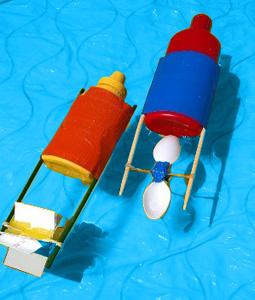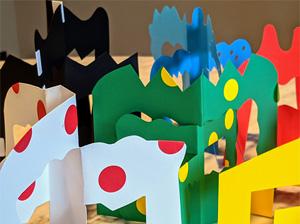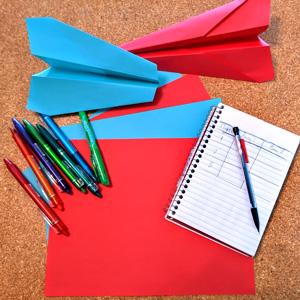Supplies:
- One plastic bottle along with its lid, about the size of a disposable water bottle (it can be a drink bottle, shampoo bottle, catsup bottle, mustard bottle, or any other clean, plastic bottle.) You can experiment with bottles of different shapes and sizes!
- Two chopsticks, new pencils, sturdy skewers, or any other straight sticks of equal size; they must be long enough to fit at least halfway along the edge of your bottle and then hang off the end by 4 to 5 inches.
- Thick foam board OR plastic carton(like a whipped cream tub or kitchen wipes container) OR two disposable plastic spoons
- Rubber bands of different sizes
- Duct tape or packing tape
- Scissors
- Paper
- Ruler
- Permanent marker
Directions:
- Line up your two sticks on opposite sides and along the length of your clean bottle; tape into place using the duct tape or packing tape (or use rubber bands if you have no tape.)
- Slide a rubber band over the ends of the sticks. Your rubber band should be taut without falling off but not so tight that it bends your sticks inward. If your rubber band is too big, try doubling it. It helps to loop the rubber band around each stick so it doesn’t fall off.
- Trace and cut a 2 inch X 3 inch template from the paper. Then use the paper template to trace 4 rectangles on the sides, bottom, or lid of a plastic container and cut them out.* The plastic should be soft enough to bend. Bend each piece in half; then use narrow pieces of duct tape to hold the pieces together with the curves flaring in opposite directions and all the bends in the middle.
- Slide your curved, taped plastic carton pieces or your taped spoons or your joined foam pieces between the sides of the rubber band. This is your paddle! At this point, you can tape the paddle to the rubber band.
- Try it out! You can sail your paddle boat in the bathtub, in a pond or quiet stream, or in a swimming or kiddie pool. Wind the paddle within the rubber band. Do it several times, but don’t wind it so much that it snaps. With the paddle still wound, set your boat gently in the water and let it go!
(Watch this project at: https://youtu.be/aFYJ9Aga7VY?list=PLxg4vmuqrAte4QgWzVQ7oInsSnnMkwcil)
* Caution: Some plastics become sharp when cut. Get an adult’s help if you need it!
Alternate method: Using a wire cutter or strong scissors, trim the handles of two plastic spoons so that they are 2 ½ inches long; use a narrow piece of duct tape to hold the spoons together along the short handle with one spoon facing up and one spoon facing down.
Second alternate method: Cut two 3 inch squares out of thick foam board and cut a slit just to the middle of each so that they can slide together.
The Science behind this Project:
The wound rubber band stores energy. The more you wind it the more energy is stored. The term for stored energy is “potential energy.” When you release the rubber band, the “potential energy” is converted into “kinetic energy,” or the energy of motion.
More experimentation:
Does the boat go faster or slower if the paddle is moved closer to the boat?
Does the boat go backwards if the paddle is wound in the other direction?
Does a big boat go faster or slower than a small boat?
When your boat is in the water, can you spot other forms of kinetic energy caused by the boat’s motion?
Can you think of other examples of potential and kinetic energy?
More ideas:
Make a balloon powered car
Make a rubber band helicopter
Supplies:
- 8 ½ x11” sheets of colored cardstock or heavyweight construction paper
- Scissors
- Colored dot stickers or other small stickers- optional
- Scraps of colorful/decorative papers- optional
- Hole punch
- Glue stick
Directions:
- Fold an 8 ½ x 11” sheet of cardstock or heavy construction paper in half OR cut the sheet to a smaller size, then fold in half, making a strong crease on the fold line.
- Holding onto the folded side of your paper with one hand, give the top of your paper a decorative trim. Still holding the folded side with one hand, begin cutting 1” in from the open side, starting at the bottom of your paper. Let the outside edge guide your cutting line. STOP when you are about 1” from the top of your paper. Turn the corner with your scissors and cut across the paper, toward the fold. STOP about ¼” from the fold!
- Repeat the cutting from the bottom of your paper, always moving over about 1” from your previous cut before beginning. You can make your vertical and horizontal cuts straight or decorative. Making lines and curves, play around with each sculpture you create, giving your pieces some variety!
- When you have made 3-4 cutting lines, depending on the size of your paper, open up your paper and lay it on a flat surface. You can decorate your paper, front and back, using stickers or scraps of paper.
- Turn your paper into a 3-D sculpture with a few folds: Beginning on one side of your sculpture, fold the top “leg” TOWARD the center, creasing a new fold at the end of your scissor cut (where you stopped about ¼” from the main fold line). The next “leg” should be folded BACKWARD in the same manner. Continue, folding each leg ... front, back ... in this alternating pattern. Do the same thing on the other side, BUT the top “leg” will be folded backward. Continue the folding pattern ... front, back, front.
- Display your 3-D sculpture by working with the “legs” and folds to make it stand. Make a few more, varying the size of your paper, cutting lines, and decorations to grow your piece into an artistic stabile (a freestanding abstract sculpture) that POPS!
Watch this project at: https://www.youtube.com/watch?v=NPxBwVPqYR4&list=PLxg4vmuqrAtckvp9eurSG…
In this project, you make two different paper airplane designs and then test out each one to determine which one will fly the furthest.
Supplies:
- Two pieces of paper for airplanes
- Markers or crayons to decorate
- Pencil and paper to record your results
Directions:
Plane Design #1- Classic Glider
- Fold your paper hot dog style.
- Lay the paper out in front of you, portrait style.
- Fold the top-right corner to the center crease, lining up the edges and creating a triangle.
- Do the same thing with the left corner.
- Fold the right side again, along the crease.
- Do the same thing with the left side.
- Fold the plane inwards, in half, so the previous folds are on the inside.
- Fold back one side so the edges align.
- Flip and repeat with the other wing.
Plane Design #2- Speed Glider
- Fold your paper hot dog style.
- Lay the paper out in front of you, portrait style.
- Fold the top-right corner to the center crease, lining up the edges and creating a triangle.
- Do the same thing with the left corner.
- Fold the point of the plane down, creating a fold along the bottom of the corner triangles. The tip should be about ⅓ of the page from the bottom of the paper.
- Fold the top-right corner to the center, about one inch above the tip.
- Repeat with the left corner. This should create a small triangle at the point.
- Fold the small triangle up.
- Flip your plane over so that your folds are on the table.
- Fold your plane in half, left side onto its right, so the edges line up.
- Fold the top wing down so your edges align.
- Flip and repeat with the other wing. Once you have completed your planes. Test them out in an open space, like your backyard or the park. Make a chart and compare each of your planes and how far it flew each time.
Watch these airplane projects at: https://youtu.be/QdronFgR0Yc?list=PLxg4vmuqrAte4QgWzVQ7oInsSnnMkwcil





